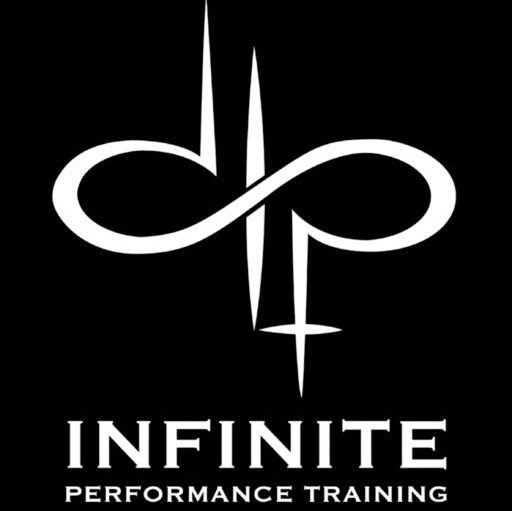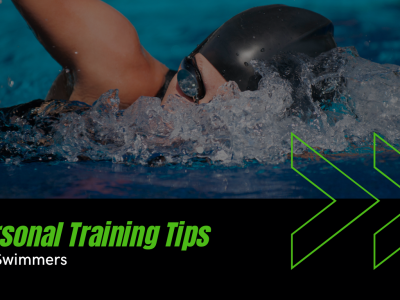Do you struggle to improve your swimming performance despite regular training? Sometimes, swimmers need more strength training to help improve their swim times.
In this post, you will help you with straightforward personal training tips specifically designed for swimmers. You will learn about the best strength exercises for swimmers that boost your performance and effective methods for tracking your progress. By following these actionable guidelines, you will overcome training plateaus and unlock better results in the pool with the team here at Infinite Performance Training!
Let’s DIVE in!
7 Personal Training Tips for Swimmers to Maximize Performance
Do you need personal training tips for swimming? Once you analyze your swim technique for better performance, the next step is to design a personalized strength regimen focusing on effective routines for swimmers. You can build a Personal Training plan that monitors your heart rate, supports nutrition and recovery, uses mental training, and adjusts training volume and intensity depending on your swimming season.
First, you will want to analyze your swim technique to figure out a baseline to improve from!
1. Analyze Your Swim Technique for Better Performance
A deep analysis of your swim technique by tracking stroke accuracy, water intake, and overall form to build a personal training plan for swimmers that improves physical fitness and endurance is key. This targeted approach helps you identify areas for improvement that can lead to faster performance in competitive environments and also measures your performance with strength training.
| Technique Aspect | Focus |
|---|---|
| Stroke Efficiency | Optimizes water flow |
| Arm Movement | Boosts fast execution |
| Overall Endurance | Supports long-term physical fitness |
2. Goal Setting Ino Your Training Plan
Setting specific goals and targets is how you get better in any sport! We help the swimmers we train set goals before designing a personalized strength training program. Perhaps it is improving your time to meet Virginia state standards or dropping your turn time. Either way, specific goals will help you design the best training plan!
3. Nutrition Strategy for Swimmers

As a swimmer, it is essential to consume enough calories daily, especially during long training sessions. Micahel Phelps, for example, consumed 10,000 calories per day to provide his body with enough fuel to train at the intensity he did.
For the swimmers trained at Infinite Performance Training, we want to ensure they are not in a calorie deficit, so knowing how much energy you burn during training sessions is vital. Next, focusing on clean carb sources and proteins is vital for optimal nutrition. We teach our swimmer training clients to avoid foods with lots of sugar!
4. Recovery Practices for Optimal Performance
Recovery is key for swimmers to prevent overtraining and injuries. You can boost overall recovery by focusing on targeted nutrition and active rest to support health and optimal range of motion, especially for the pectoralis major in case of any injury. Consider incorporating these strategies into your routine to maintain peak performance and reduce downtime:
- Monitor your nutrition to support muscle repair
- Implement active recovery exercises to maintain range of motion
- Focus on targeted exercises for the pectoralis major
- Rest adequately to prevent further injury
5. Mental Training Techniques for Competitive Swimming
You can sharpen your competitive edge by incorporating mental training techniques that help you focus and maintain composure during intense front crawl and long jump exercises. You benefit from strategies often used in physical therapy, which aid in sustaining muscle endurance and recovery, allowing you to perform at your best and push through physical challenges effectively.
6. Monitor and Adjust Training Volume and Intensity
Monitor your training volume and adjust the intensity to enhance your speed in the pool. With guidance from a personal trainer like CJ, you can incorporate land exercises to support lung capacity while maintaining steady progress, ensuring your performance moves as swiftly as a fish in water.
7. Implement Dryland Training Strategies for Stability and Strength
All swimmers should incorporate dryland drills using a medicine ball to strengthen their core while working on their leg stability, including targeted exercises that support their thigh and ankle strength. You can complement this training with foam routines to improve balance and stability, ensuring you perform best during pool sessions.
GET IN TOUCH
Schedule a Training Session
Best Strength Exercises to Boost Swimming Performance
Want the best strength exercises for swimmers?
While there will always be some debate, we recommend pull-ups, squats, medicine ball drills, deadlifts, and plyometric moves to build your strength. This expert-backed plan works alongside bench press and yoga to support your rotator cuff health and reduce stress, ensuring peak performance. Each exercise offers a practical step toward improved overall power and endurance.
1. Pull-Ups to Build Upper Body Strength
You know that incorporating pull-ups into your swimming weight workouts significantly builds your upper body strength, which is essential for improved backstroke efficiency and overall endurance. You enhance your performance in and out of the pool by integrating pull-ups with proper stretching routines and using tools like a dryland swim trainer or kettlebell for complementary exercises. This approach addresses your immediate physical training needs and helps you reach a higher level of competitive readiness.
2. Squats to Improve Leg Power and Endurance
You use squats to boost your leg power and improve core stability while engaging your hip muscles, which is particularly beneficial for sprinting, running, and preparing for a triathlon; this exercise plays a pivotal role in your overall swimming performance and helps you overcome common training obstacles:
| Exercise Focus | Benefits |
|---|---|
| Leg Power | Increases strength and speed during sprints |
| Core Stability | Enhances balance and support for effective strokes |
| Hip Development | Improves motion control and power transfer |
| Triathlon and Running Endurance | Builds sustained strength for long-distance events |
3. Integrate Medicine Ball Exercises for Core Stability
You integrate medicine ball exercises to fortify your torso and support overall stability, which is vital for any athlete looking to improve performance in their sport. You use a resistance band alongside medicine ball workouts to effectively target the quadriceps and core muscles, delivering noticeable improvements in balance and power. You notice that consistent practice in this area builds a robust foundation, enabling you to execute strokes with greater precision and reduce strain during intensive training sessions.
4. Deadlifts for Overall Strength Development
Swimmers don’t have to deadlift a ton of weight, but the overall strength deadlifts provide is vital to your swimming ability. By focusing on deadlifts to build overall strength, you positively affect your biceps, knee stability, and rowing power while boosting your confidence as you progress like a pro, which in turn reinforces your performance in every swim stroke and drill:
| Exercise | Benefits |
|---|---|
| Deadlifts | It improves overall strength, enhances knee stability, and builds endurance for rowing and swimming |
5. Develop Explosive Power With Plyometric Exercises
Swimmers need to develop explosive power by integrating plyometric exercises into their training routines, where focusing on weight-bearing drills challenges their foot stability and boosts their overall athletic performance. Drawing from your experience and current knowledge, you can target your triceps and other key muscle groups to improve burst power, making your strokes sharper and more effective in the pool.
Tips for Tracking Progress in Strength Training

You use a swim log to monitor performance metrics and set specific strength goals, tracking achievements as you build flexibility and a stable shoulder joint. You analyze training data to refine your bodybuilding routine and adjust your exercise plan, and you stay accountable with peer support and coaching for consistent progress.
Use a Swim Log to Monitor Performance Metrics
You keep a swim log to capture laps, stroke counts, and rest periods, which enables you to track progress and adjust your strength training accordingly. Recording these details provides a direct view of your performance metrics, guiding you to enhance endurance and technique over time. This practice helps you pinpoint minor improvements that collectively boost your overall performance in the pool.
Set Specific Strength Goals and Track Achievements
You set clear strength milestones and record your progress to maintain focus and increase accountability during your workouts. Tracking exercise details and improvements gives you valuable insight that directly helps you tailor your training plan to boost overall swimming performance.
Analyze Training Data to Adjust Exercise Routine
You review your training data regularly to pinpoint patterns and adjust your exercise routine, ensuring your strength workouts remain effective and focused. Analyzing figures such as lap counts, repetitions, and muscle engagement gives you actionable insights that help streamline your training and boost swimming performance. Hands-on analysis enables you to recognize areas needing balance, refine workout volume, and target specific muscle groups for optimal endurance and stability in the pool.
Stay Accountable With Peer Support and Coaching
You stay accountable by connecting with training partners and working with a dedicated coach who reviews your strength performance regularly, ensuring you remain focused during personal training sessions. Engaging with others in your community helps you track your progress, receive customized feedback, and adjust your routines as necessary, allowing you to overcome barriers and continue making steady improvements. This supportive environment directly contributes to achieving better results in the pool through a strong and consistent training regimen.
Swim Performance and Training
You can find valuable insights in recommended books that focus on swim performance and training, helping you build a stronger foundation for your workouts and refine your technique for better results:
| Title | Focus |
|---|---|
| Swim Training Fundamentals | Builds a strong training base |
| Advanced Stroke Mechanics | Improves technique and endurance |
| Strength for Swimmers | Integrates strength exercises into swim routines |
The Verdict on Swimming Strength Training
The best swimmers train hard, eat well, and recover often! Our philosophy for swimmers here at Infinite Performance Training of Gainiesville, VA, is simple: Workout and train with us, and you will get better!
We have helped countless swimmers in the DMW with personal training plans customized for their needs as swimmers. Personal training for swimmers is becoming increasingly popular, and strength training is a must for swimmers looking to compete at the next level! To learn more about our training programs, feel free to reach out to us below:
Frequently Asked Questions
1. What tips enhance personal training for swimmer performance?
Include targeted strength routines, stroke technique drills, and flexibility work to boost performance. Regular progress tracking and proper recovery maximize training gains. Maintaining focus and gradually increasing challenge levels help you achieve improved speed and endurance in swimming.
2. Which exercises boost strength for swimmers?
Building a strong core, leg, and upper body base supports swimmers just as we secure concrete foundations for homeowners. Incorporating push-ups, squats, and planks boosts power, stability, and endurance for your training.
3. How do you track swimming progress?
Record lap times, monitor distance, and note stroke techniques. Use apps or wearable devices to track improvements and adjust your training routine for noticeable progress in your swimming skills.
4. What training routines support strength and swimming?
Incorporating resistance exercises, core workouts, and swimming drills improves power and endurance while targeting strength and efficiency in the water. Routine interval training also supports muscle support, aiding swimmers to achieve balanced performance.
5. Where are extra personal training resources available?
Extra personal training resources can be found on reputable sports training websites, local community centers, and specialized forums where fellow swimmers share insightful guidance for improving their swimming and general fitness skills.


 4 Key Benefits of Foam Rolling for Athletes
4 Key Benefits of Foam Rolling for Athletes
Leave a Reply